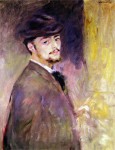
Pierre-Auguste Renoir
French, 1841-1919
Coastline at Antibes, 1888
oil on canvas
25 5/8 × 32 1/8 in.
Michael Armand Hammer and the Armand Hammer Foundation
Loan

Pierre-Auguste Renoir, Self Portrait, Oil on canvas, 1876, Fogg Art Museum, Cambridge, USA
"An artist, under pain of oblivion, must have confidence in himself, and listen only to his real master: Nature." - Pierre-Auguste Renoir
COMMENTS
The changes evident in Renoir’s style during the 1880s, a new firmness in his drawing and a return to classical order in composition, were principally confined to his figure paintings. In the conventional composition of this landscape, a more relaxed handling of paint and the suppression of contour have resulted in a misty softness that is almost dreamlike in effect. Yet the artist’s love of the sensuality of warm color saves the scene from undertones of melancholy. He has used tiny brushstrokes and feathered the paint so delicately that there is no build-up of any kind of impasto; the canvas appears as if it were gently stained, rather than brushed, with pigment. Small and indistinct figures, possibly a studio invention, are subsumed by the pleasant somnolence of their natural surroundings— a direct contrast to the liveliness of Grape Pickers at Lunch, where landscape was molded to accentuate figural representation. The clear white verticals of a gatepost balanced by white sails on the Mediterranean are the only abrupt notes in this idyllic rendition of nature.
Renoir, who was primarily a figural painter and always thought of himself as such, considered landscape to be a difficult and ever-challenging genre. “Landscapes are the painter’s stumbling block,” he said in a 1918 interview with a collector. “You think it’s gray, but how many colors there are in a gray landscape! If you only knew, Monsieur, how hard it is to anatomize a tree with a brush.”
By the turn of the century, the artist’s Impressionist view of landscape as a means of capturing an actual moment of reality suspended in time had evolved into an older, more traditional attitude. He envisioned works such as Coastline at Antibes as a continuation of the French school of ideal landscape that had flourished since the early eighteenth century. In his last years he would voice some of this sentiment to the same visitor: “I can’t paint nature, I know, but the hand-to-hand struggle with her stimulates me. A painter can’t be great if he doesn’t understand landscape. At one time the term ‘landscapist’ was one of scorn, especially in the 18th century. And yet that century, which I adore, produced great landscape artists. I am of the 18th century. I humbly consider not only that my art descends from Watteau, Fragonard, Hubert Robert, but even that I am one of them. Watteau, what a genius!”
It is no accident that Coastline at Antibes reminds one of Corot’s mist-shrouded visions of the forest near Barbizon in the mid-nineteenth century or of the gentle, wistful paintings created by Watteau more than 100 years earlier. Yet the warmth of color and delicate, ethereal brushwork of the Hammer painting stamp it indelibly as a product of Renoir’s own distinct temperament.
- William Gaunt, Renoir, Phaidon Press, 1952
Like Monet, alongside whom he painted outdoors during their excursions to the South, Renoir was attracted to the brilliant light and lush folliage of the Mediterranean coast. The billowing robes and headdress of the figures, however, appear to be exoticizing afterthought, probably added later by the artist in his studio to introduce narrative interest. Like the romantic artist Eugene Delacroix (1798-1863) whom he admired, Renoir made repeated trips to Algiers in the early 1880s, in serach of exotic subjects.
- The Armand Hammer Collection: Five Centuries of Masterpieces, Los Angeles, 1981
SBMA CURATORIAL LABELS
During the 1880s, Renoir’s art drifted towards classicism, in part due to a renewed engagement with the masters of the Italian Renaissance, such as Raphael. This new phase in his art was characterized by monumental figural subjects, whether female bathers or society portraits. However, the delicate, feathery brushwork he had developed during the Impressionist years of the previous decade is still evident in his landscapes, as in this luscious example. Like Monet, alongside whom he painted outdoors during their excursions to the South, Renoir was attracted to the brilliant light and lush foliage of the Mediterranean coast. The billowing robes and headdresses of the figures, however, appear to be an exoticizing afterthought, probably added later by the artist in his studio to introduce narrative interest. Like the Romantic artist Eugène Delacroix (1798 – 1863), whom he admired, Renoir made repeated trips to Algiers in the early 1880s, in search of exotic subjects.
- Ridley-Tree Gallery, 2016
